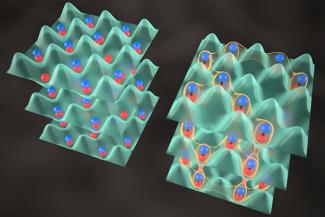JILA’s cold molecule collaboration (Jin and Ye Groups, with theory support from the Rey Group) recently made a breakthrough in its efforts to use ultracold polar molecules to study the complex physics of large numbers of interacting quantum particles. By closely packing the molecules into a 3D optical lattice (a sort of “crystal of light”), the team was able to create the first “highly degenerate” gas of ultracold molecules. In other words, the ultracold molecular gas was much closer to the lowest possible entropy than ever before. This accomplishment has made it feasible to use the ultracold polar molecules for practical studies of such complicated phenomena as quantum magnetism.
Because of its goal of studying complex quantum phenomena, the collaboration has learned to produce ultracold molecules in a 3D optical lattice, which resembles a 3D egg carton of regularly spaced energy wells created by intersecting laser beams. When placed inside the energy wells in the lattice, individual ultracold molecules can “talk loudly” to nearby molecules above and below them as well as to their left and right. There’s also some weaker communication with molecules farther away. The team’s recent achievement is to fill enough of these energy wells with cold molecules to establish a working communications network, in which every molecule in the lattice must participate.
With JILA’s potassium-rubidium (KRb) molecules, enough turns out to be approximately one KRb molecule for every three or four lattice sites. At this density, the molecules are able to get well connected with each other, making it feasible to study their complex interacting network. Graduate student Steven Moses and his team from the Jin and Ye collaboration were recently able to create KRb molecules in a large enough fraction of the lattice sites to get the molecules well connected. Their work was published online in Science on November 6, 2015.
To make the molecules inside the lattice, the researchers had to first place atoms inside the lattice in such a way that many sites contained a single potassium atom and a single rubidium atom. Then, with a small change in the magnetic field, they turned pairs of atoms into KRb molecules. However, the first step of getting a pair of different atoms into many sites turned out to be the biggest challenge. But, the cold-molecule collaboration met the challenge of getting the potassium and rubidium atoms to “like” each other well enough to sit side by side on the same site.
To make them sit peacefully together, the researchers had to deal with many issues. First, potassium and rubidium are very different animals, and as different species, they like different things. Potassium atoms are fermions, which prefer to keep their distance from other atoms, and rubidium atoms are bosons, which don’t mind a lot of close contact. Second, potassium and rubidium have different masses. Plus they experience the trap made by light differently. Finally, the potassium atoms are hotter than rubidium atoms, and harder to cool. With all these differences, it was challenging to place just one Rb atom and one K atom next to each other in the same well. In fact, it turned out it to be best for the K and Rb atoms to completely ignore each other until it was time to turn them into molecules! This unexpected result had to be confirmed experimentally and now has been explained by the Rey theory group.
When it was time to make the molecules, the researchers used a small change in the magnetic field through a Feshbach resonance to create such a strong interaction between atoms that they linked up and formed weakly bound molecules [1]. The weakly bound molecules were converted to long-lived ground-state molecules with a pair of lasers.
In the end, the researchers succeeded in creating a thousand splendid KRb molecules, each snugly tucked away in its own lattice site. And, there were enough pairs to establish a communications network. Now, the Jin and Ye collaboration is building an improved experimental apparatus that will allow them to see the molecules much more clearly. This new ability to watch the behavior of individual molecules in the lattice will lead to future investigations of communication pathways, spin-orbit coupling, and other quantum behaviors. Stay tuned.––Julie Phillips
[1] A Feshbach resonance is a special magnetic-field strength where small changes in the magnetic field have dramatic effects on the interactions of atoms in an ultracold gas.




